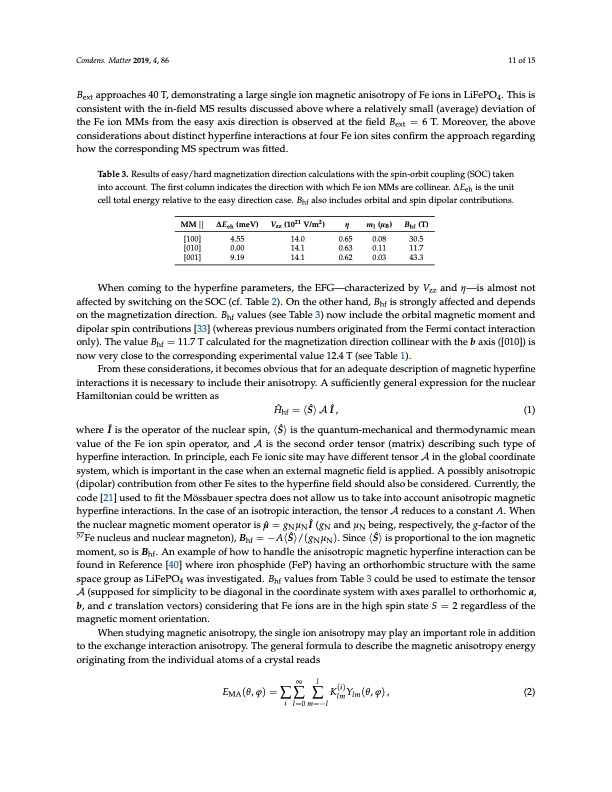
PDF Publication Title:
Text from PDF Page: 011
Condens. Matter 2019, 4, 86 11 of 15 Bext approaches 40 T, demonstrating a large single ion magnetic anisotropy of Fe ions in LiFePO4. This is consistent with the in-field MS results discussed above where a relatively small (average) deviation of the Fe ion MMs from the easy axis direction is observed at the field Bext = 6 T. Moreover, the above considerations about distinct hyperfine interactions at four Fe ion sites confirm the approach regarding how the corresponding MS spectrum was fitted. Table 3. Results of easy/hard magnetization direction calculations with the spin-orbit coupling (SOC) taken into account. The first column indicates the direction with which Fe ion MMs are collinear. ∆Eeh is the unit cell total energy relative to the easy direction case. Bhf also includes orbital and spin dipolar contributions. MM || [100] [010] [001] ∆Eeh (meV) 4.55 0.00 9.19 Vzz (1021 V/m2) η 14.0 0.65 14.1 0.63 14.1 0.62 ml (μB) 0.08 0.11 0.03 Bhf (T) 30.5 11.7 43.3 When coming to the hyperfine parameters, the EFG—characterized by Vzz and η—is almost not affected by switching on the SOC (cf. Table 2). On the other hand, Bhf is strongly affected and depends on the magnetization direction. Bhf values (see Table 3) now include the orbital magnetic moment and dipolar spin contributions [33] (whereas previous numbers originated from the Fermi contact interaction only). The value Bhf = 11.7 T calculated for the magnetization direction collinear with the b axis ([010]) is now very close to the corresponding experimental value 12.4 T (see Table 1). From these considerations, it becomes obvious that for an adequate description of magnetic hyperfine interactions it is necessary to include their anisotropy. A sufficiently general expression for the nuclear Hamiltonian could be written as Hˆhf =⟨Sˆ⟩AIˆ, (1) where Iˆ is the operator of the nuclear spin, ⟨Sˆ⟩ is the quantum-mechanical and thermodynamic mean value of the Fe ion spin operator, and A is the second order tensor (matrix) describing such type of hyperfine interaction. In principle, each Fe ionic site may have different tensor A in the global coordinate system, which is important in the case when an external magnetic field is applied. A possibly anisotropic (dipolar) contribution from other Fe sites to the hyperfine field should also be considered. Currently, the code [21] used to fit the Mössbauer spectra does not allow us to take into account anisotropic magnetic hyperfine interactions. In the case of an isotropic interaction, the tensor A reduces to a constant A. When the nuclear magnetic moment operator is μˆ = gNμN Iˆ (gN and μN being, respectively, the g-factor of the 57Fe nucleus and nuclear magneton), Bhf = −A⟨Sˆ⟩/(gNμN). Since ⟨Sˆ⟩ is proportional to the ion magnetic moment, so is Bhf. An example of how to handle the anisotropic magnetic hyperfine interaction can be found in Reference [40] where iron phosphide (FeP) having an orthorhombic structure with the same space group as LiFePO4 was investigated. Bhf values from Table 3 could be used to estimate the tensor A (supposed for simplicity to be diagonal in the coordinate system with axes parallel to orthorhomic a, b, and c translation vectors) considering that Fe ions are in the high spin state S = 2 regardless of the magnetic moment orientation. When studying magnetic anisotropy, the single ion anisotropy may play an important role in addition to the exchange interaction anisotropy. The general formula to describe the magnetic anisotropy energy originating from the individual atoms of a crystal reads ∞l EMA(θ,φ)=∑∑ ∑ KlmYlm(θ,φ), (2) (i) i l=0 m=−lPDF Image | Mossbauer Spectroscopy of Triphylite (LiFePO4) at Low Temperatures

PDF Search Title:
Mossbauer Spectroscopy of Triphylite (LiFePO4) at Low TemperaturesOriginal File Name Searched:
condensedmatter-04-00086.pdfDIY PDF Search: Google It | Yahoo | Bing
Sulfur Deposition on Carbon Nanofibers using Supercritical CO2 Sulfur Deposition on Carbon Nanofibers using Supercritical CO2. Gamma sulfur also known as mother of pearl sulfur and nacreous sulfur... More Info
CO2 Organic Rankine Cycle Experimenter Platform The supercritical CO2 phase change system is both a heat pump and organic rankine cycle which can be used for those purposes and as a supercritical extractor for advanced subcritical and supercritical extraction technology. Uses include producing nanoparticles, precious metal CO2 extraction, lithium battery recycling, and other applications... More Info
| CONTACT TEL: 608-238-6001 Email: greg@infinityturbine.com | RSS | AMP |